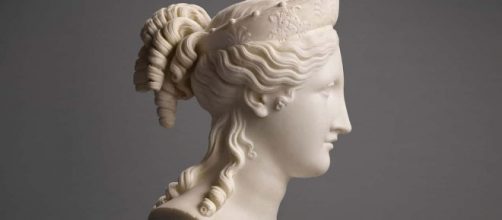This is big news in the art world: a white marble carving of a woman's head by 18th century sculptor Antonio Canova -- unseen for more than two centuries -- has surfaced at Sotheby's auction house in London. Titled “Bust of Peace,” the work speaks to the artist's idea of ideal beauty, and it's so drop-dead gorgeous that you're left to wonder who the model was.
Who is the mystery woman?
Lord Byron, taken to such a degree by “Bust of Peace” that he penned a poem about it, saw the face of Helen of Troy – once regarded the most beautiful woman in the world – or as he put it, “beyond imagination's power.” If not Helen, who?
Several women posed for Canova including those in the Bonaparte family, like Napoleon's newly-wed Empress Marie Louise and his sister Pauline Bonaparte Borghese. Was one of them the model for “Bust of Peace"?
Beauty is in the eye of the beholder
After reading the sculptor's memoirs, I wind up thinking that “Bust of Peace” was inspired by the looks of a fellow student at an art academy in Venice, As Canova recounted the encounter, a woman somewhat older than he was and very beautiful entered the room where he was sketching relics. She came every day accompanied by an attendant, who departed soon after arriving, and returned again before the hour of closing, leaving her to pursue her studies which chiefly consisted of drawing antique heads.
One day chance placed them near each other and she praised his work as "assai bello.” He stayed silent and hoped for another time to have her attention. But she stopped coming to class after that. Only her attendant appeared one day – in deep mourning and as she passed him to depart with a portfolio he asked where her companion was. “La Senora Julia,” she replied, bursting into tears, “is dead.” Nothing more was said. Who Julia was Canova never learned, but her name and face remained in his memory.
Profile in courage
Canova's thoughts about sculpting showed up in correspondence with an archaeologist friend. He told him that it takes more than borrowing from antiquities to make art. “It needs sweating day and night over the Greek models, imbibing their style, and turning it into one's own blood.” You imagine seeing his blood in “Bust of Peace.” You also imagine you see Julia.
He clearly admired her hair, given all his extraordinary attention to the way it curls at the neck. More importantly, he endowed her face with an air of great calm and quiet without any sense of passivity. Instead, you see determination on her face. If she's the woman at the art academy, if she's Julia who died before her time, she likely knew she was dying and that's what Canova captured: her bravery while facing her own mortality.


